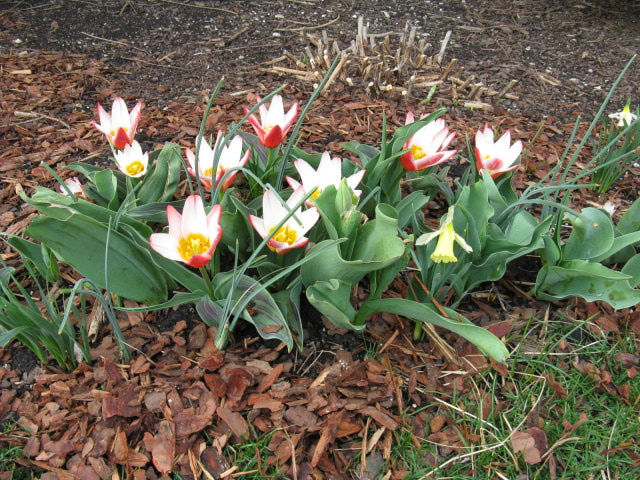QuestionQUESTION: Hi Donna,
I have a nice patch of Iris leaves but i got only 1 beareded iris bloom this year. I have had this patch for 4 years and no flowers. I have always loved irises because my grandmother always had such beautiful irises. Can you tell me what i need to do to get them to bloom? I transplanted some this past spring and the rihzomes and nice and healthy. I live in Southern Ontario
Any advice would be greatly appreciated
Also i was reading your advice on Voles. i certainly will try your suggestions. Darn things ate all my tulip bulbs last year.
 WP Milner daff with tu
WP Milner daff with tu
ANSWER: Greetings Cynthia,
I am sorry that you have been disappointed in this year's iris blooms. There are several possible reasons why you are getting so few. Let's go through some of them.
The first thing I should tell your is that bearded iris are not happy being moved. They often take a few years to really settle in and perform. Therefore, they should be placed in locations in which they can remain for several years. This explains why the ones you just moved are not blooming well. It may also explain why the ones you moved four years ago seem sleepy. And another factor is sun. Do the irises you moved have at least six full hours of sun each day?
When you moved them, were they fertilized? Not with high nitrogen fertilizers, which are bad, but was the soil in which you put them the type with a nutrient balance iris prefer?
Were they planted too deeply? The rhizomes should be planted such that they are at or just below the soil surface or you get lots of leaves but no flowers. Is this a possibility?
Please review these and write again, and we will move forward from there.
By the way, regarding voles, my advice has altered over the years. I first realized I needed to do something when I lost 50 lilies in a single year, some of them irreplaceable. I used to use sharp gravel or Voleblok (aka Permatil) but a MUCH better solution (did you read this?) is daffodils. They are poisonous to both rabbits and voles. I often recommend using the Division 1 tiny trumpet WP Milner. Why Milner? Well, the downside to daffodils is the big hulking foliage that lasts forever. Milner has tiny delicate foliage that melts away quickly. Also, daffodils in the "Miniature" category are very expensive, whereas Milner is cheap and widely available. And you can leave them in the ground - well, forever. Any cheap small tulip will do. Just don't buy the ridiculous ones described as miniatures that often cost $1.00 each or more.
See the attached picture. This is one of my favorite tulips. The Kaufmann tulip 'Hearts Delight'. Darned voles and rabbits would eat it every year. See the tiny tulip? That's Milner.
Is this helpful? We may not yet have found the solution, but please give some thought to my suggestions above, and fee; free to contact me again. I will be back later today if that is helpful.
Beat wishes,
Donna
---------- FOLLOW-UP ----------
QUESTION: Hi Donna,
Moving the irises, Now that explains alot. No wonder my grandmothers irises were so beautiful she left them alone.
I can see the ryzomes of the irises just peaking out of the ground. What would you suggest for a fertilizer? I planted them in black garden soil, and under that was clay. My husband made me a garden box above the ground and that is where they are.
Thank you for your help.
AnswerHello again Cynthia. It's nice to hear from you again.
Normally, irises don't require much fertilizer, but - you planted them with "garden soil." The kind that comes in bags? It is probably not sufficient to the needs of your irises. I usually plant with really good compost, which is sometimes sold as blended compost. A good blended compost helps to break up clay. I lived in clay land before my move three years ago. Clay has wonderful nutrients in it, but it is better broken down by the use of compost. Then the plant can get to the nutrients in the clay.
But - if they bloom poorly, there are fertilizers that help. Again, avoid high nitrogen fertilizers and look for a low nitrogen, high phosphorous one, like a 5-10-5 blend. Sprinkle about half a cup around each iris clump, approximately six inches from the base of the plant. Have your watering can nearby, because it is important to water the fertilizer in immediately.
You will need to let your plants settle in, but you can be on the right track to having the lovely flowers your grandmother had.
I hope that this is helpful. If anything is unclear, or you simply have more questions, please do not hesitate to write again.
Regards,
Donna






